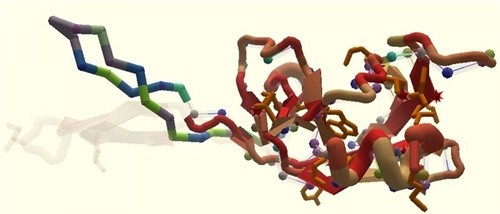Breakthrough For Retroviral Drug Design As Gamers Unfold Elusive Enzyme Structure

In an extraordinary breakthrough, online game players have pieced together the molecular structure of the mysterious retrovirus enzyme that has baffled scientists for more than a decade. This is the first case in which researchers and gamers have teamed up together to solve an age-old scientific problem.
The gamers discovered the viable structure by playing Foldit, the online game based on a software program developed by computer scientists at the University of Washington Centre for Game Science in collaboration with the Baker lab. Foldit enables players to pool resources and compete in predicting the structure of protein molecules.
Following repeated failure in discovering the structure of a protein-cutting enzyme from an AIDS-like virus, scientists challenged the gamers to produce an accurate model of the enzyme.
Within three weeks the gamers were able to generate models good enough for the researchers to refine and determine the enzyme's structure.
The gamer teams such as Foldit Contenders Group and Foldit Void Crushers Group were challenged to take up real-world molecule modelling problems. The online protein folding game has engaged thousands of players globally.
The research paper co-authored by the scientists and gamers was published in the September issue of Nature Structural & Molecular Biology.
We wanted to see if human intuition could succeed where automated methods had failed, said Dr. Firas Khatib of the University Of Washington Department Of Biochemistry. Khatib is a researcher in the protein structure lab of Dr. David Baker, professor of biochemistry.
These features provide exciting opportunities for the design of retroviral drugs, including AIDS drugs, wrote the authors.
They explained that the class of enzymes, called retroviral proteases, is critical in understanding how the AIDS virus matures and proliferates. The knowledge on the molecular structure through further research is under way to try and design anti-AIDS drugs that can block these enzymes.
Most studies on the structure of these proteases were hampered in the past as scientists were not aware of the molecular configuration of these enzymes.
People have spatial reasoning skills, something computers are not yet good at, said Dr. Seth Cooper, of the UW Department of Computing Science and Engineering and co-creator, lead designer and developer of Foldit.
Games provide a framework for bringing together the strengths of computers and humans. The results in this week's paper show that gaming, science and computation can be combined to make advances that were not possible before, he said.
To piece together the retrovirus enzyme structure, Cooper said, gamers used a new Alignment Tool for the first time to copy parts of known molecules and test their fit in an incomplete model.
It is known that bonds between the atoms in the enzyme's molecules can be twisted and turned in a million possible ways but the challenge lies in developing the right chemical key such that the design is the most efficient, lowest-energy variant of the molecule.
The Foldit software enables players to manipulate molecular structures virtually that look like multicoloured, curled-up Tinker toy sets. The virtual molecules obey the same chemical rules as that exhibited by their real molecular counterparts.
Someone who plays the game and creates a more elegant structure of the molecule with a lower energy state scores more points. If the structure requires more energy to maintain, or if it does not comply with real-life chemistry, then the score drops accordingly.
The game taps into their 3-D spatial abilities to rotate chains of amino acids in cyberspace. New players start at the basic level, One Small Clash, proceeds to Swing it Around and step ahead until reaching Rubber Band Reversal.
The researchers noted that much attention has been given to the possibilities of crowd-sourcing and game playing in scientific discovery. Their results indicate the potential for integrating online video games into real-world science.
Direct manipulation tools, as well as assistance from a computer program called Rosetta, encouraged participants to configure graphics into a workable protein model. Teams send in their answers, and UW researchers constantly improved the design of the game and its puzzles by analyzing the players' problem-solving strategies.
Figuring out the shape and misshape of proteins contributes to research on causes of and cures for cancer, Alzheimer's, immune deficiencies and a host of other disorders, as well as to environmental work on bio fuels. The ingenuity of game players, Khatib said, is a formidable force that, if properly directed, can be used to solve a wide range of scientific problems.
The focus of the UW Centre for Game Sciences, said director Dr. Zoran Popovic, associate professor of computer science and engineering, is to solve hard problems in science and education that currently cannot be solved by either people or computers alone.
According to Popovic, Foldit shows that a game can turn novices into domain experts capable of producing first-class scientific discoveries. We are currently applying the same approach to change the way math and sciences are taught in school.
© Copyright IBTimes 2025. All rights reserved.



















